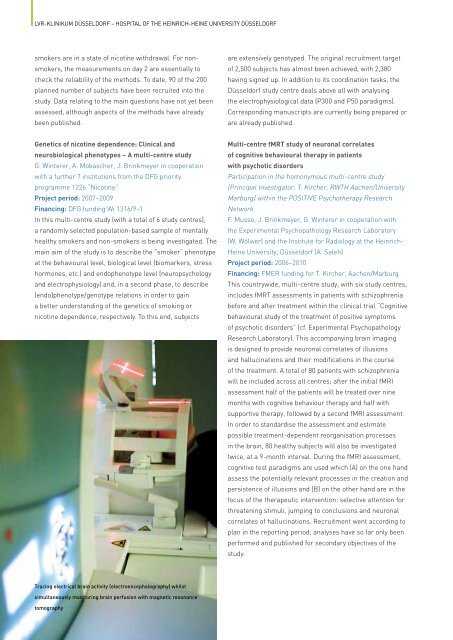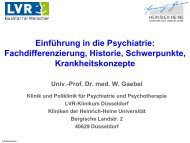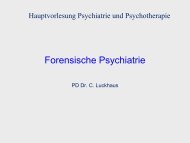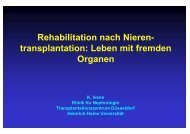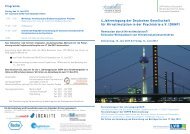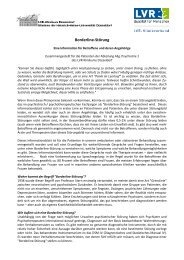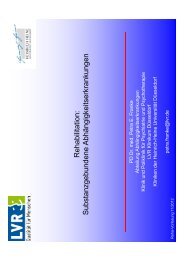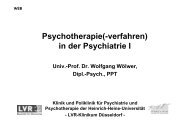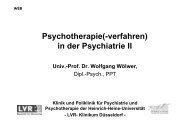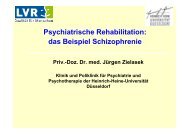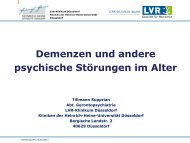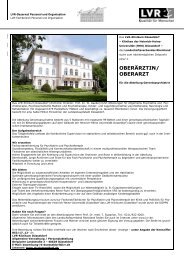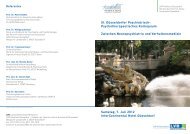LVR-Klinikum Düsseldorf Hospital of the Heinrich-Heine University ...
LVR-Klinikum Düsseldorf Hospital of the Heinrich-Heine University ...
LVR-Klinikum Düsseldorf Hospital of the Heinrich-Heine University ...
You also want an ePaper? Increase the reach of your titles
YUMPU automatically turns print PDFs into web optimized ePapers that Google loves.
<strong>LVR</strong>-KLINIKUM DÜsseLDORF – hOsPITaL OF The heINRIch-heINe UNIVeRsITY DÜsseLDORF<br />
smokers are in a state <strong>of</strong> nicotine withdrawal. For nonsmokers,<br />
<strong>the</strong> measurements on day 2 are essentially to<br />
check <strong>the</strong> reliability <strong>of</strong> <strong>the</strong> methods. To date, 90 <strong>of</strong> <strong>the</strong> 200<br />
planned number <strong>of</strong> subjects have been recruited into <strong>the</strong><br />
study. Data relating to <strong>the</strong> main questions have not yet been<br />
assessed, although aspects <strong>of</strong> <strong>the</strong> methods have already<br />
been published.<br />
Genetics <strong>of</strong> nicotine dependence: Clinical and<br />
neurobiological phenotypes – A multi-centre study<br />
G. Winterer, A. Mobascher, J. Brinkmeyer in cooperation<br />
with a fur<strong>the</strong>r 7 institutions from <strong>the</strong> DFG priority<br />
programme 1226 “Nicotine”<br />
Project period: 2007–2009<br />
Financing: DFG funding Wi 1316/9-1<br />
In this multi-centre study (with a total <strong>of</strong> 6 study centres),<br />
a randomly selected population-based sample <strong>of</strong> mentally<br />
healthy smokers and non-smokers is being investigated. The<br />
main aim <strong>of</strong> <strong>the</strong> study is to describe <strong>the</strong> “smoker” phenotype<br />
at <strong>the</strong> behavioural level, biological level (biomarkers, stress<br />
hormones, etc.) and endophenotype level (neuropsychology<br />
and electrophysiology) and, in a second phase, to describe<br />
(endo)phenotype/genotype relations in order to gain<br />
a better understanding <strong>of</strong> <strong>the</strong> genetics <strong>of</strong> smoking or<br />
nicotine dependence, respectively. To this end, subjects<br />
Tracing electrical brain activity (electroencephalography) whilst<br />
simultaneously monitoring brain perfusion with magnetic resonance<br />
tomography<br />
86<br />
are extensively genotyped. The original recruitment target<br />
<strong>of</strong> 2,500 subjects has almost been achieved, with 2,380<br />
having signed up. In addition to its coordination tasks, <strong>the</strong><br />
<strong>Düsseldorf</strong> study centre deals above all with analysing<br />
<strong>the</strong> electrophysiological data (P300 and P50 paradigms).<br />
Corresponding manuscripts are currently being prepared or<br />
are already published.<br />
Multi-centre fMRT study <strong>of</strong> neuronal correlates<br />
<strong>of</strong> cognitive behavioural <strong>the</strong>rapy in patients<br />
with psychotic disorders<br />
Participation in <strong>the</strong> homonymous multi-centre study<br />
(Principal Investigator: T. Kircher, RWTH Aachen/<strong>University</strong><br />
Marburg) within <strong>the</strong> POSITIVE Psycho<strong>the</strong>rapy Research<br />
Network<br />
F. Musso, J. Brinkmeyer, G. Winterer in cooperation with<br />
<strong>the</strong> Experimental Psychopathology Research Laboratory<br />
(W. Wölwer) and <strong>the</strong> Institute for Radiology at <strong>the</strong> <strong>Heinrich</strong>-<br />
<strong>Heine</strong> <strong>University</strong>, <strong>Düsseldorf</strong> (A. Saleh)<br />
Project period: 2006–2010<br />
Financing: FMER funding for T. Kircher, Aachen/Marburg<br />
This countrywide, multi-centre study, with six study centres,<br />
includes fMRT assessments in patients with schizophrenia<br />
before and after treatment within <strong>the</strong> clinical trial “Cognitive<br />
behavioural study <strong>of</strong> <strong>the</strong> treatment <strong>of</strong> positive symptoms<br />
<strong>of</strong> psychotic disorders” (cf. Experimental Psychopathology<br />
Research Laboratory). This accompanying brain imaging<br />
is designed to provide neuronal correlates <strong>of</strong> illusions<br />
and hallucinations and <strong>the</strong>ir modifications in <strong>the</strong> course<br />
<strong>of</strong> <strong>the</strong> treatment. A total <strong>of</strong> 80 patients with schizophrenia<br />
will be included across all centres; after <strong>the</strong> initial fMRI<br />
assessment half <strong>of</strong> <strong>the</strong> patients will be treated over nine<br />
months with cognitive behaviour <strong>the</strong>rapy and half with<br />
supportive <strong>the</strong>rapy, followed by a second fMRI assessment.<br />
In order to standardise <strong>the</strong> assessment and estimate<br />
possible treatment-dependent reorganisation processes<br />
in <strong>the</strong> brain, 80 healthy subjects will also be investigated<br />
twice, at a 9-month interval. During <strong>the</strong> fMRI assessment,<br />
cognitive test paradigms are used which (A) on <strong>the</strong> one hand<br />
assess <strong>the</strong> potentially relevant processes in <strong>the</strong> creation and<br />
persistence <strong>of</strong> illusions and (B) on <strong>the</strong> o<strong>the</strong>r hand are in <strong>the</strong><br />
focus <strong>of</strong> <strong>the</strong> <strong>the</strong>rapeutic intervention: selective attention for<br />
threatening stimuli, jumping to conclusions and neuronal<br />
correlates <strong>of</strong> hallucinations. Recruitment went according to<br />
plan in <strong>the</strong> reporting period; analyses have so far only been<br />
performed and published for secondary objectives <strong>of</strong> <strong>the</strong><br />
study.


